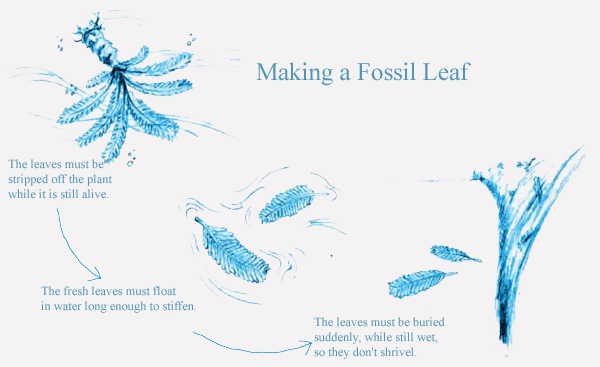Four: Amazingly Preserved Leaves
When leaves die, they shrivel up and crumble. So why is the fossil record full of well-preserved, flat leaves?
Our high school biology teacher gave us homework over the summer: put together a plant collection. Unfortunately, when fall arrived, not all the collections looked like plants! Unless you follow special directions, plants shrivel, brown, and crumble soon after being picked. Perhaps such an assignment—or trying to preserve a rare four-leaf clover or a favorite flower—is the only way to understand how difficult it is to preserve a plant.
With this thought in mind, the vast number of fossil plants at Mazon Creek (near Chicago, Illinois) is remarkable. Not only are the leaves well preserved, but they are quite flat—flatter, in fact, than they were when they were alive! How is this?
The mystery deepens when one realizes that Mazon Creek is not unique. Similar well-preserved, flattened fossils are found around the world.

These are just a sample of the millions of fossilized leaves that have been recovered from the Mazon Creek deposit near Chicago. What catastrophic process could preserve so many leaves so splendidly? Photo courtesy of Creation Museum.
Under special conditions, leaves will become rigid today. If a green leaf is stripped from a plant and submerged in water, the still-living cells will swell, stretching the flexible membrane surrounding the cells and pressing against cell walls outside that membrane. (This process, called turgor pressure, causes wilting house plants to straighten when watered.)
If a leaf is dead when it falls into water, however, nothing happens. The reason is simple. When a plant “dies” (biologically speaking), the membranes surrounding the cells break and shrink away from the cell walls.
So we deduce that special conditions must have produced the leaves in the fossil record:
Step 1: The leaves must have been ripped off while the plants were still alive.
Step 2: The leaves must have been carried in water long enough for water to enter the cells and stiffen (flatten) the leaves.
Step 3: Since leaves curl up as soon as the water drains away, the flattened leaves must have been buried before the water left the cells.
The Bible’s account of a global flood provides the clues that help us solve the mystery of how these leaves could be deposited worldwide.
The Bible’s description of a global Flood provides the clues that help us solve the mystery of how these leaves could be deposited worldwide. As rising water inundated the earth, we would expect the plants to be ripped up and then float in water, before sinking and being buried.
The catastrophe destroyed more than just one kind of leaf. The Mazon Creek fossils include many kinds of small ground plants (such as ferns), intermediate-sized trees (such as tree ferns), and very tall trees (such as giant scale trees, which are now extinct). Every part of each of those plants (from roots to bark, branches, leaves, flowers, and seeds) has been found, as well as varied animals that probably lived with those plants. So it seems that parts of an entire ecosystem were suddenly destroyed and buried in some watery catastrophe.
Similar fossil localities with the same plants are found across the eastern United States, Europe, and westernmost Asia. So it seems that both the ecosystem and the catastrophe must have been huge—at least the size of a continent. That’s just what might be expected of a global flood!
When evaluated through the lens of Scripture, Mazon Creek fossil leaves confirm what is written on the leaves of the Bible.

Normally leaves shrivel up soon after they die. So why do we find so many leaves so well preserved worldwide—even flatter than they are in life? A unique combination of events, unlike anything we see today, would make this “wonder” possible. God’s Word gives us a record of events like this.
Answers Magazine
January – March 2010
Fossils are filled with mystery. They are commonly used to attack the biblical worldview, but in reality the Bible gives us the keys to help us solve these mysteries. How could recently discovered dinosaur tissue have survived until today? Why is the first fossil layer filled with such an astonishing variety of life (“the Cambrian Explosion”)? Read this issue to understand these and other mysteries of our world!
Browse IssueRecommended Resources

Answers in Genesis is an apologetics ministry, dedicated to helping Christians defend their faith and proclaim the good news of Jesus Christ.
- Customer Service 800.778.3390
- Available Monday–Friday | 9 AM–5 PM ET
- © 2026 Answers in Genesis




